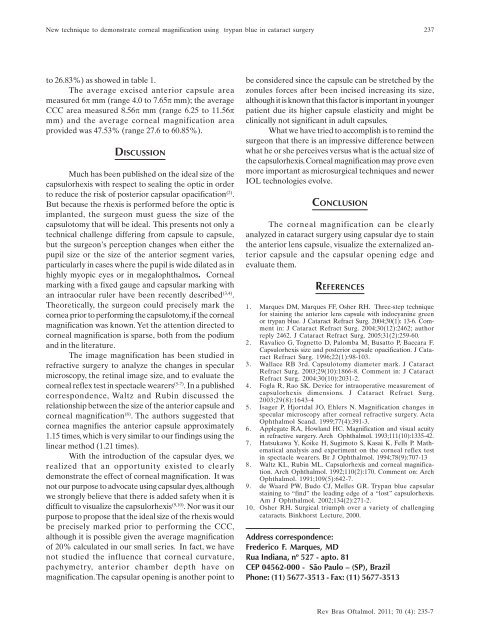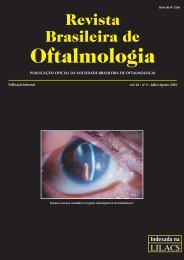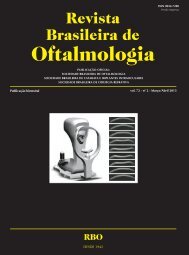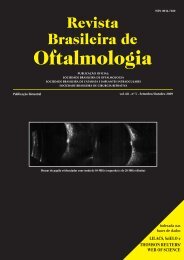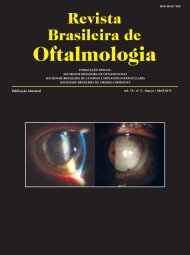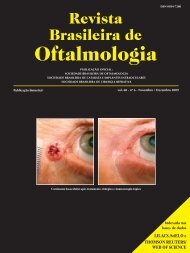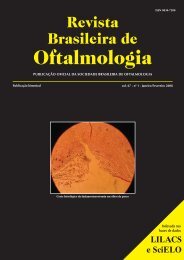New technique to <strong>de</strong>monstrate corneal magnification using trypan blue in cataract surgery237to 26.83%) as showed in table 1.The average excised anterior capsule areameasured 6π mm (range 4.0 to 7.65π mm); the averageCCC area measured 8.56π mm (range 6.25 to 11.56πmm) and the average corneal magnification areaprovi<strong>de</strong>d was 47.53% (range 27.6 to 60.85%).DISCUSSIONMuch has been published on the i<strong>de</strong>al size of thecapsulorhexis with respect to sealing the optic in or<strong>de</strong>rto reduce the risk of posterior capsular opacification (2) .But because the rhexis is performed before the optic isimplanted, the surgeon must guess the size of thecapsulotomy that will be i<strong>de</strong>al. This presents not only atechnical challenge differing from capsule to capsule,but the surgeon’s perception changes when either thepupil size or the size of the anterior segment varies,particularly in cases where the pupil is wi<strong>de</strong> dilated as inhighly myopic eyes or in megalophthalmos. Cornealmarking with a fixed gauge and capsular marking withan intraocular ruler have been recently <strong>de</strong>scribed (3,4) .Theoretically, the surgeon could precisely mark thecornea prior to performing the capsulotomy, if the cornealmagnification was known. Yet the attention directed tocorneal magnification is sparse, both from the podiumand in the literature.The image magnification has been studied inrefractive surgery to analyze the changes in specularmicroscopy, the retinal image size, and to evaluate thecorneal reflex test in spectacle wearers (5-7) . In a publishedcorrespon<strong>de</strong>nce, Waltz and Rubin discussed therelationship between the size of the anterior capsule andcorneal magnification (8) . The authors suggested thatcornea magnifies the anterior capsule approximately1.15 times, which is very similar to our findings using thelinear method (1.21 times).With the introduction of the capsular dyes, werealized that an opportunity existed to clearly<strong>de</strong>monstrate the effect of corneal magnification. It wasnot our purpose to advocate using capsular dyes, althoughwe strongly believe that there is ad<strong>de</strong>d safety when it isdifficult to visualize the capsulorhexis (9,10) . Nor was it ourpurpose to propose that the i<strong>de</strong>al size of the rhexis wouldbe precisely marked prior to performing the CCC,although it is possible given the average magnificationof 20% calculated in our small series. In fact, we havenot studied the influence that corneal curvature,pachymetry, anterior chamber <strong>de</strong>pth have onmagnification. The capsular opening is another point tobe consi<strong>de</strong>red since the capsule can be stretched by thezonules forces after been incised increasing its size,although it is known that this factor is important in youngerpatient due its higher capsule elasticity and might beclinically not significant in adult capsules.What we have tried to accomplish is to remind thesurgeon that there is an impressive difference betweenwhat he or she perceives versus what is the actual size ofthe capsulorhexis. Corneal magnification may prove evenmore important as microsurgical techniques and newerIOL technologies evolve.CONCLUSIONThe corneal magnification can be clearlyanalyzed in cataract surgery using capsular dye to stainthe anterior lens capsule, visualize the externalized anteriorcapsule and the capsular opening edge an<strong>de</strong>valuate them.REFERENCES1. Marques DM, Marques FF, Osher RH. Three-step techniquefor staining the anterior lens capsule with indocyanine greenor trypan blue. J Cataract Refract Surg. 2004;30(1): 13-6. Commentin: J Cataract Refract Surg. 2004;30(12):2462; authorreply 2462. J Cataract Refract Surg. 2005;31(2):259-60.2. Ravalico G, Tognetto D, Palomba M, Busatto P, Baccara F.Capsulorhexis size and posterior capsule opacification. J CataractRefract Surg. 1996;22(1):98-103.3. Wallace RB 3rd. Capsulotomy diameter mark. J CataractRefract Surg. 2003;29(10):1866-8. Comment in: J CataractRefract Surg. 2004;30(10):2031-2.4. Fogla R, Rao SK. Device for intraoperative measurement ofcapsulorhexis dimensions. J Cataract Refract Surg.2003;29(8):1643-45. Isager P, Hjortdal JO, Ehlers N. Magnification changes inspecular microscopy after corneal refractive surgery. ActaOphthalmol Scand. 1999;77(4):391-3.6. Applegate RA, Howland HC. Magnification and visual acuityin refractive surgery. Arch Ophthalmol. 1993;111(10):1335-42.7. Hatsukawa Y, Koike H, Sugimoto S, Kasai K, Fells P. Mathematicalanalysis and experiment on the corneal reflex testin spectacle wearers. Br J Ophthalmol. 1994;78(9):707-138. Waltz KL, Rubin ML. Capsulorhexis and corneal magnification.Arch Ophthalmol. 1992;110(2):170. Comment on: ArchOphthalmol. 1991;109(5):642-7.9. <strong>de</strong> Waard PW, Budo CJ, Melles GR. Trypan blue capsularstaining to “find” the leading edge of a “lost” capsulorhexis.Am J Ophthalmol. 2002;134(2):271-2.10. Osher RH. Surgical triumph over a variety of challengingcataracts. Binkhorst Lecture, 2000.Address correspon<strong>de</strong>nce:Fre<strong>de</strong>rico F. Marques, MDRua Indiana, nº 527 - apto. 81CEP 04562-000 - São Paulo – (SP), BrazilPhone: (11) 5677-3513 - Fax: (11) 5677-3513Rev Bras Oftalmol. 2011; 70 (4): 235-7
238ARTIGO ORIGINALPerfil da <strong>de</strong>manda e morbida<strong>de</strong> dos pacientesatendidos em centro <strong>de</strong> urgênciasoftalmológicas <strong>de</strong> um hospital universitárioDemand profile and morbidity among patients treatedat service of ophthalmic urgencies in a university hospitalFre<strong>de</strong>rico Braga Pereira 1 , Maria Frasson 2 , Ana Gabriela Zum Bach D’Almeida 1 , Aline <strong>de</strong> Almeida 3 ,Daniela Faria 1 , Júlia Francis 4 , João Neves <strong>de</strong> Me<strong>de</strong>iros 5RESUMOObjetivo: Proporcionar análise epi<strong>de</strong>miológica dos pacientes atendidos no Serviço <strong>de</strong> Urgência Oftalmológica doHospital São Geraldo. Métodos: Foi realizado estudo <strong>de</strong>scritivo prospectivo no período <strong>de</strong> setembro <strong>de</strong> 2005 a janeiro <strong>de</strong>2006 através <strong>de</strong> questionário <strong>de</strong> atendimento diário contendo sexo, ida<strong>de</strong>, raça, ocupação e procedência dos pacientes,diagnóstico principal (<strong>de</strong> acordo com a Classificação Internacional <strong>de</strong> Doenças – 10ª revisão) e as condutas adotadas.Resultados: Foram atendidos 8.346 pacientes, 3.819 mulheres (45,79%) e 4.521 homens (54,20%). A faixa etária variou <strong>de</strong> 0a 100 anos e o grupo <strong>de</strong> ocupações mais frequente foi o <strong>de</strong> serviços gerais (24,20%). O diagnóstico mais frequente foiconjuntivite (27,91%). A conduta mais adotada foi o tratamento medicamentoso (65,5%). Conclusão: A maioria dos atendimentosfoi classificada como urgência oftalmológica. As causas não traumáticas foram as mais inci<strong>de</strong>ntes. O Hospital SãoGeraldo <strong>de</strong>sempenha um papel importante no atendimento à urgência oftalmológica da re<strong>de</strong> pública, na região <strong>de</strong> BeloHorizonte e cida<strong>de</strong>s vizinhas.Descritores: Oftalmopatias/epi<strong>de</strong>miologia; Emergências; Conjuntivite; Corpos estranhos no olho; Traumatismos ocularesABSTRACTObjective: Establish an epi<strong>de</strong>miological analysis of patients assisted in an urgency service of a university eye hospital(Hospital São Geraldo). Methods: This is a prospective and <strong>de</strong>scriptive study, conducted from september 2005 to january 2006.A questionnaire was used for the purpose of gathering daily information about all the patients assisted in the service. Informationwas collected on age, sex, occupation, ethnicity, origin of the patient, primary diagnosis (according to International Classificationof Disease – ICD 10 ) and the approaches adopted. Results: 8.346 patients were assisted, 3.819 female (45,79%) and 4.521 male(54,20%). The ages ranged from 0 to 100 years and the most common group of occupations was general services (24,20%). Themost frequent diagnosis was conjunctivitis (27,91%). The most common measure taken was the drug treatment (65,5%).Conclusion: The majority of treatment was classified as urgency. The non-traumatic causes were the most frequent diseases. SãoGeraldo Hospital plays an important role, as a public service, in treating ophthalmic urgencies of Belo Horizonte region andsurrounding towns.Keywords: Eye diseases/epi<strong>de</strong>miology; Emergencies; Conjunctivitis; Eye foreign bodies; Eye injuries1Médico Oftalmologista, preceptor do Serviço <strong>de</strong> Urgência em <strong>Oftalmologia</strong> do Hospital São Geraldo/Hospital das Clínicas –Universida<strong>de</strong> Fe<strong>de</strong>ral <strong>de</strong> Minas Gerais – UFMG – Belo Horizonte (MG), Brasil;2Médica Oftalmologista do Hospital São Geraldo, Hospital das Clínicas - Universida<strong>de</strong> Fe<strong>de</strong>ral <strong>de</strong> Minas Gerais – UFMG – BeloHorizonte (MG), Brasil;3Médica Oftalmologista graduada pela Faculda<strong>de</strong> <strong>de</strong> Medicina da Universida<strong>de</strong> Fe<strong>de</strong>ral <strong>de</strong> Minas Gerais – UFMG – Belo Horizonte(MG), Brasil. Em exercício no Município <strong>de</strong> Diamantina (MG), Brasil;4Médica Oftalmologista, realizando “fellowship” em glaucoma na Clínica <strong>de</strong> Olhos da Santa Casa <strong>de</strong> Belo Horizonte (MG), Brasil;5Médico, Gestor do Instituto <strong>de</strong> Olhos do Hospital Universitário São José, Belo Horizonte (MG), Brasil.Trabalho realizado no Hospital São Geraldo, Hospital das Clínicas da Universida<strong>de</strong> Fe<strong>de</strong>ral <strong>de</strong> Minas Gerais – UFMG – BeloHorizonte (MG), BrasilOs autores <strong>de</strong>claram inexistir conflitos <strong>de</strong> interesseRecebido para publicação em: 20/10/2010 - Aceito para publicação em 30/6/2011Rev Bras Oftalmol. 2011; 70 (4): 238-42
- Page 1 and 2: vol. 70 - nº 4 - Julho / Agosto 20
- Page 3 and 4: 204Revista Brasileira de Oftalmolog
- Page 5 and 6: 206235 New technique to demonstrate
- Page 7 and 8: 208 Ambrósio Júnior RGerard Mouro
- Page 9 and 10: 210Ambrósio Júnior RDiferentes pl
- Page 11 and 12: 212Cronemberger S, Faria DS, Reiman
- Page 13 and 14: 214Cronemberger S, Faria DS, Reiman
- Page 15 and 16: 216Cronemberger S, Faria DS, Reiman
- Page 17 and 18: 218ARTIGO ORIGINALUso profilático
- Page 19 and 20: 220Oliveira PRP, Simão LF, Simão
- Page 21 and 22: 222Oliveira PRP, Simão LF, Simão
- Page 23 and 24: 224ARTIGO ORIGINALPercepção da ad
- Page 25 and 26: 226Portes AJF, Silva MGO, Viana M,
- Page 27 and 28: 228Portes AJF, Silva MGO, Viana M,
- Page 29 and 30: 230ARTIGO ORIGINALExpectativas e co
- Page 31 and 32: 232Kara-Junior N, Mourad PCA , Esp
- Page 33 and 34: 234Kara-Junior N, Mourad PCA , Esp
- Page 35: 236 Marques FF, Marques DMV, Osher
- Page 39 and 40: 240Pereira FB, Frasson M, D’Almei
- Page 41 and 42: 242Pereira FB, Frasson M, D’Almei
- Page 43 and 44: 244 Corso DD, Bonamigo EL, Corso MA
- Page 45 and 46: 246Corso DD, Bonamigo EL, Corso MA,
- Page 47 and 48: 248RELATO DE CASOPupila dilatada fi
- Page 49 and 50: 250Batista JLA, Grisolia ABD, Pazos
- Page 51 and 52: 252RELATO DE CASOPolypoidal choroid
- Page 53 and 54: 254Amaro MH, Roller AB, Motta CTPS,
- Page 55 and 56: 256Amaro MH, Roller AB, Motta CTPS,
- Page 57 and 58: 258Biancardi AL, Ambrosio Júnior R
- Page 59 and 60: 260Biancardi AL, Ambrosio Júnior R
- Page 61 and 62: 262Amaro MH, Amaro FAH, Roller AB,
- Page 63 and 64: 264Amaro MH, Amaro FAH, Roller AB,
- Page 65 and 66: 266Amaro MH, Amaro FAH, Roller AB,
- Page 67 and 68: 268Instruções aos autoresA Revist
- Page 69: 270RevistaBrasileira deOftalmologia


